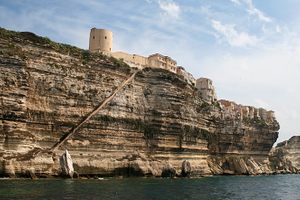About
Although standing stones are typically associated with Brittany and the British Isles, the Mediterranean island of Corsica is likewise home to many examples of these mystifying prehistoric monuments. Nestled amongst the hills of the Taravo Valley, Filitosa is the largest single site of megalithic statuary in Corsica.
While archaeological evidence suggests that the site was inhabited as early as 3300 BCE (as evidenced by arrowheads and pottery, as well as extant stone enclosures and hut foundations), the earliest standing stones were not erected until 1500 BCE. The standing stones at Filitosa are all menhirs: tall, tapering, upright stones, measuring 7-8 feet in height. While some were merely fashioned into rough rectangles, others were shaped into human faces and forms, carrying weapons and wearing armor.
Like so many other old rocks left standing around by our forebears, little is known about either the purpose of the menhirs of Filitosa, or the people who made them. While some suggest they were phallic symbols built to encourage fertile fields, Roger Grosjean — the archaeologist that began excavation of the site in 1954, and a pretty interesting guy in his own right — believed the menhirs resembling warriors were made in the likeness of an invading group, in order to incarcerate their power in stone and ward off their encroachments. Indeed, it does seem that the original inhabitants of Filitosa were ultimately supplanted by a group called the Torreans, who broke up dozens of menhirs for use in the construction of two towers (hence the name “Torrean,” from “torre” or “tower”) on the site of their conquest. The two towers with their constituent menhir bits can still be seen at Filitosa today.
Due to extensive excavation and study, the menhirs of Filitosa do not currently stand where they were found, but rather have been arranged in a manner conducive to viewing by contemporary visitors. Nevertheless, the human resonance in the late Neolithic/early Bronze Age handiwork is unmistakable across millennia. A new museum opened at Filitosa in 2015 to showcase the findings and carry on the message of this significant archaeological site.
Related Tags
Published
November 19, 2015































